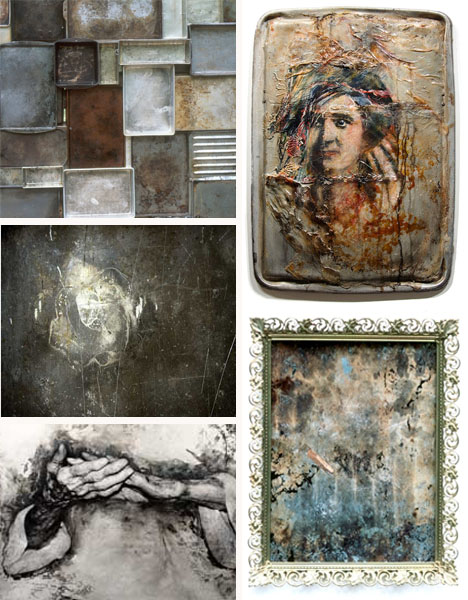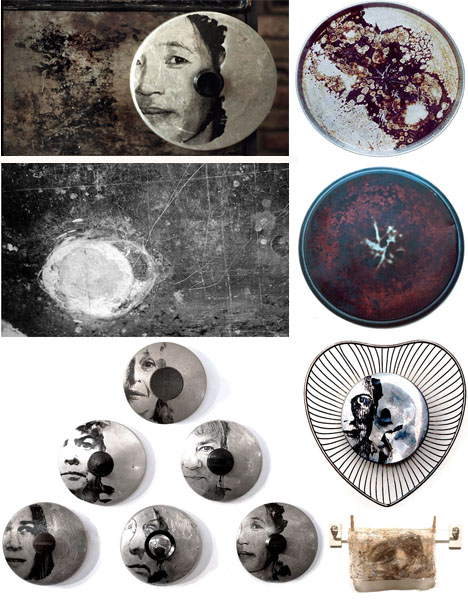
Try as we might, maintaining the factory-line glimmer of a freshly minted set of baking pans or cookie sheets becomes increasingly more challenging with each new casserole or dessert that we make. Although one greatly celebrated
chemical-free cleansing recipe promises to restore metal kitchenware to its former glory with nothing more than the magical duo of baking soda and hydrogen peroxide (not to mention a bit of elbow grease), busy schedules, acidic/oily foods and plain old oxidation inevitably take their collective toll, robbing these stalwarts of the kitchen of their once youthful good looks.
Who really wants to spend their free time scrubbing the heck out of broiler trays and casserole pans, anyway? Even when you
do go the extra mile, they are always one lasagna away from looking like a historical relic, but oddly enough, that suits
Sally Mankus just fine.
Unlike the majority of us, who might look at a sorry, old rust-covered pan and happily give it the final send off to our garbage cans, this photographer, sculptor and all-around right-brained professional perceives humble, well-worn and even decaying objects as the ideal medium for her creative inclinations.
A long-time collector of overlooked domestic objects such as pot lids,
pans,
baking sheets, trays,
napkins and
clothespins, as well as
heirloom quilts, vintage fabrics,
towels, spools of thread, tablecloths, table runners, napkins,
lace doilies,
handkerchiefs, family letters, film and antique photos, Mankus has spent years
selectively arranging and incorporating such materials into
esthetically pleasing displays that ultimately
enhance household décor. Rather than being chucked in a scrap heap or a landfill, Mankus likes the idea of transforming historical domestic workhorses into pieces of art that garner a special place within our homes.
Drawn to the untapped beauty that lies within these artifacts of everyday life, the Florida-based multimedia artist finds the unique, mottled, rusted and even charred patina of well-worn pot and pan lids manufactured by Kitchen Craft, WearEver and Queen cookware particularly appealing, but she is more than happy to use any brand emblazoned with unique typography or images on the handles. The older and more imperfect its appearance, the better.
Sourced from thrift stores, garage sales and the generous donations of friends, family and art-enthusiastic strangers (who have been known to mail or even deposit surprise parcels on her doorstep), Mankus uses her assorted cookware lids in two unique ways. Not only as
individual metallic canvases bearing a vast range of digitally manipulated photographic transfers (created with bakeware-extracted rust and carbon deposits), but also as an integral part of her
larger-scale artistic grid-style installations.

The
multi-award-winning artist says that her current flair for arrangement and presentation has evolved over time — not only through research, experimentation and random inspiration, but also through occasional happy accidents. Like repeatedly driving over pans in order to
make the surfaces far more receptive to artistic alteration, or firing cookware in an open pit in order to enhance markings or further accentuate their time-worn appearance.
While Mankus’ artwork certainly has an eco-edge to it, she prefers being regarded simply as a multimedia artist who embraces the use of historical relics. She definitely makes a conscious effort to lead an environmentally responsible, minimalistic lifestyle, however.
Like many of us, she totes reusable bags, recycles, reuses and donates items whenever possible, and drops hazardous waste items off at her local community collection center. Additionally, Mankus eschews grass in favor of a low-maintenance yard, regularly commutes via bicycle rather than automobile, gets her informational fix via an e-reader and saves documents on her computer for future reference rather than printing hard copies.
Furthermore, she is intimately familiar with green construction, given the home she and her husband built years ago utilizing a combination of various energy-efficient systems, insulated window shades with magnetic seals and a heat-retention mass storage wall. While the couple have since changed their address, Mankus says that when they’re ready to build their next home, they intend to make it a green affair.
For now, though, Mankus, who claims she still has “a lot to learn” in the eco-sphere, continues refining and expanding her artistic efforts. Apparently, she doesn’t realize just how valuable a teacher she has already been to those of us who are dialed into a sustainable way of life — before she came on the scene, using garbage can-bound cookware in art was virtually nonexistent.
Like her fellow contemporaries who have conjured up innovative and visually striking ways to utilize waste (think Judith and Richard Lang’s
three-dimensional ocean-pollution assemblages or Josh Blackwell’s
recycled plastic bag tapestries), Sally Mankus’ unexpectedly artful reconfiguration of practical domestic tools serves as the latest reminder of the rich creative potential lying within arm’s length of our garbage cans.



